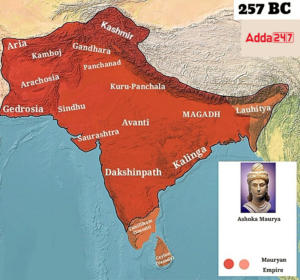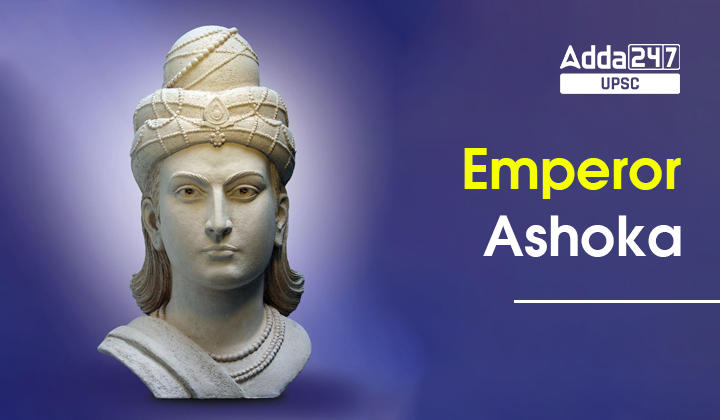Table of Contents
Ashoka, known as Ashoka the Great, stands as one of the most influential rulers of ancient India, reigning from 268 to 232 BCE. His rule marks a pivotal moment in Indian history, characterized by significant political, social, and religious developments. This article offers a concise overview of Ashoka Biography, ascent to power, reign, and his profound impact on the spread of Buddhism across Asia.
Who was Ashoka?
Below is a table summarizing key events in the life of Ashoka, a pivotal figure in Indian history. Born in 304 BCE in Pataliputra, Ashoka ascended the Mauryan Empire throne in 268 BCE, ruling until his death in 232 BCE. His reign was marked by extensive reforms aimed at enhancing his subjects’ welfare. Following the transformative Kalinga War, Ashoka renounced violence and adopted Buddhism.
| Event | Date | Place |
|---|---|---|
| Birth of Ashoka | 304 BCE | Pataliputra, present-day Patna, India |
| Ascension to the throne | 268 BCE | Mauryan Empire, India |
| Reign as Emperor of the Mauryan Empire | 268 BCE – 232 BCE | India |
| Promulgation of Edicts of Buddhism | 250 BCE – 231 BCE | South Asia and European Subcontinent |
| Death of Ashoka | 232 BCE | Pataliputra, present-day Patna, India |
Ashoka’S Life
- He was the third king of the Mauryan dynasty and succeeded his father to the throne in 268 BCE.
- Ashoka’s early life was marked by intense competition for the throne with his half-brothers, and he became the king only after a brutal war.
- Initially, Ashoka followed in the footsteps of his grandfather and father and was known for his military conquests.
- He played a crucial role in expanding the Mauryan Empire to its greatest extent, from present-day Afghanistan in the west to Bangladesh in the east and from the Himalayas in the north to the Deccan Plateau in the south.
- However, the Kalinga War of 261 BCE proved to be a turning point in Ashoka’s life. The brutal and bloody conflict deeply affected him, and he renounced violence and embraced Buddhism.
- From then on, Ashoka became known as a compassionate ruler who promoted non-violence, social justice, and religious tolerance.
- He implemented numerous reforms aimed at improving the lives of his subjects, such as building roads and hospitals and promoting trade and commerce.
Death of Ashoka
- Ashoka, one of India’s most significant rulers and a promoter of Buddhism, passed away in 232 BCE.
- He had ruled the Mauryan Empire for 38 years, during which he had implemented numerous reforms aimed at improving the lives of his subjects.
- After his death, the Mauryan Empire began to decline, and several successors to the throne struggled to maintain the unity and stability of the empire.
Also Read:- Mughal Empire
Ashoka’s Religion
Ashoka’s religious beliefs underwent a significant transformation during his reign as the Emperor of the Mauryan Empire. While he was initially a follower of Hinduism, he was deeply affected by the brutalities of the Kalinga War and turned to Buddhism as a means of promoting non-violence and social justice.
Power of Ashoka
- Ashoka’s rise to power began with his father, Emperor Bindusara, who appointed him as the governor of the province of Avanti.
- During his time as governor, Ashoka demonstrated his leadership skills and strategic abilities, earning the trust and respect of his father and other members of the royal court.
- After Bindusara’s death, a power struggle ensued between Ashoka and his half-brothers for the throne. Ashoka emerged victorious, but only after a long and bloody war.
- Once he became king, Ashoka continued the expansionist policies of his father and grandfather and quickly set out to conquer new territories.
- He successfully conquered the eastern province of Kalinga, which proved to be a turning point in his life and reign. The brutal and bloody conflict deeply affected Ashoka and led him to renounce violence and embrace Buddhism.
- Following his conversion to Buddhism, Ashoka began a program of reform aimed at improving the lives of his subjects. He built roads, hospitals, and rest houses, and promoted trade and commerce.
- He also implemented policies aimed at promoting social justice and religious tolerance, such as abolishing the practice of slavery and establishing religious freedom for all.
- Ashoka’s rise to power and subsequent conversion to Buddhism had a profound impact on the Mauryan Empire, and his legacy continues to be felt to this day.
Ashoka History
Here are some important points about Ashoka’s life and reign:
- Ashoka was the third emperor of the Maurya Dynasty and ruled from 268 to 232 BCE.
- He conquered the Kalinga region in 261 BCE, which resulted in the deaths of over 100,000 people and led to a profound change in
- Ashoka’s personality and policies.
- After the Kalinga war, Ashoka embraced Buddhism and became a promoter of peace and nonviolence.
- He introduced several welfare measures for his subjects, including the construction of hospitals, schools, and roads.
- Ashoka sent Buddhist missionaries to various parts of the world, including Sri Lanka, Nepal, and Tibet.
- He convened the Third Buddhist Council in Pataliputra to standardize the Buddhist scriptures and practices.
Ashoka Reign
Ashoka’s reign was marked by several significant events and reforms, including:
- The establishment of a centralized administration with a well-organized bureaucracy.
- The issuance of edicts and inscriptions on pillars and rocks to inform his subjects about his policies and beliefs.
- The construction of several monuments, including the famous Ashoka Pillars, which featured inscriptions in several languages.
- The patronage of Buddhism and other religions, as well as the promotion of animal welfare and environmental conservation.
- The introduction of a judicial system based on Dharma and the protection of the rights of women and marginalized groups.

Ashoka’s Path of Peace & Criticism
After the Kalinga war, Ashoka embraced Buddhism and renounced violence. He believed in the principle of ahimsa (nonviolence) and promoted the path of peace and harmony. He issued a series of edicts that emphasized the importance of moral and ethical values, social welfare, and religious tolerance.
However, some scholars have criticized Ashoka’s policies as being too paternalistic and authoritarian. They argue that his promotion of Buddhism and his attempts to control the thoughts and behavior of his subjects were contrary to the principles of a democratic and pluralistic society.
Ashoka Kalinga War
- The Kalinga War was a major turning point in the life and reign of Ashoka, one of India’s most significant rulers.
- The war took place in 261 BCE when Ashoka was the king of the Mauryan Empire and was expanding his territory through conquest.
- Kalinga was a powerful and prosperous kingdom located in present-day Odisha and parts of Andhra Pradesh.
- The war was one of the bloodiest in Indian history, with hundreds of thousands of soldiers and civilians killed or injured.
- The brutality of the war deeply affected Ashoka, who realized the true cost of his military conquests.
- He renounced violence and embraced Buddhism, becoming a compassionate and tolerant ruler who worked to improve the lives of his subjects.
- The Kalinga War was a turning point in Indian history, as it led to the spread of Buddhism and the promotion of non-violence and social justice throughout India and other parts of Asia.
Ashoka Spread of Buddhism
- Ashoka played a crucial role in the spread of Buddhism throughout India and other parts of Asia.
- After renouncing violence and embracing Buddhism following the Kalinga War, Ashoka became a devout Buddhist and worked tirelessly to promote the religion.
- He sent Buddhist missionaries to other parts of India and neighboring countries, such as Sri Lanka and Nepal, to spread the teachings of Buddhism.
- Ashoka also built numerous Buddhist monasteries and shrines, such as the famous Sanchi Stupa, which became important pilgrimage sites for Buddhists.
- He also used his royal patronage to support Buddhist institutions and scholars and encouraged the translation and dissemination of Buddhist texts in different languages.
- Ashoka’s efforts to promote Buddhism had a profound impact on Indian society and culture and helped establish Buddhism as one of the major religions of India.
- His legacy continued to be felt throughout Asia, as Buddhism spread to other countries such as China, Japan, and Korea, where it continues to be an important religion to this day.
Ashoka Administration
The table above summarizes some of the key aspects of Ashoka’s administration during his reign as the Emperor of the Mauryan Empire.
| Aspect of Administration | Description |
|---|---|
| Centralized administration | Ashoka established a highly centralized administration, with a hierarchy of officials responsible for governance at the imperial, provincial, and local levels. |
| Dhamma policy | Ashoka’s Dhamma policy aimed to promote ethical and moral values among his subjects, and involved the construction of roads, hospitals, and other public works. |
| Use of spies | Ashoka employed a network of spies to monitor the activities of officials and ensure loyalty to the empire. |
| Legal reforms | Ashoka introduced numerous legal reforms, including the abolition of the death penalty and the establishment of a system of fines and punishments for criminal offenses. |
| Patronage of the arts | Ashoka was a patron of the arts and encouraged the development of literature, sculpture, and other forms of artistic expression. |
| Military | Ashoka maintained a powerful army and used military force to expand and defend the Mauryan Empire. However, following the Kalinga War, he renounced violence and adopted a policy of non-violence and tolerance. |



 TSPSC Group 1 Question Paper 2024, Downl...
TSPSC Group 1 Question Paper 2024, Downl...
 TSPSC Group 1 Answer key 2024 Out, Downl...
TSPSC Group 1 Answer key 2024 Out, Downl...
 UPSC Prelims 2024 Question Paper, Downlo...
UPSC Prelims 2024 Question Paper, Downlo...
